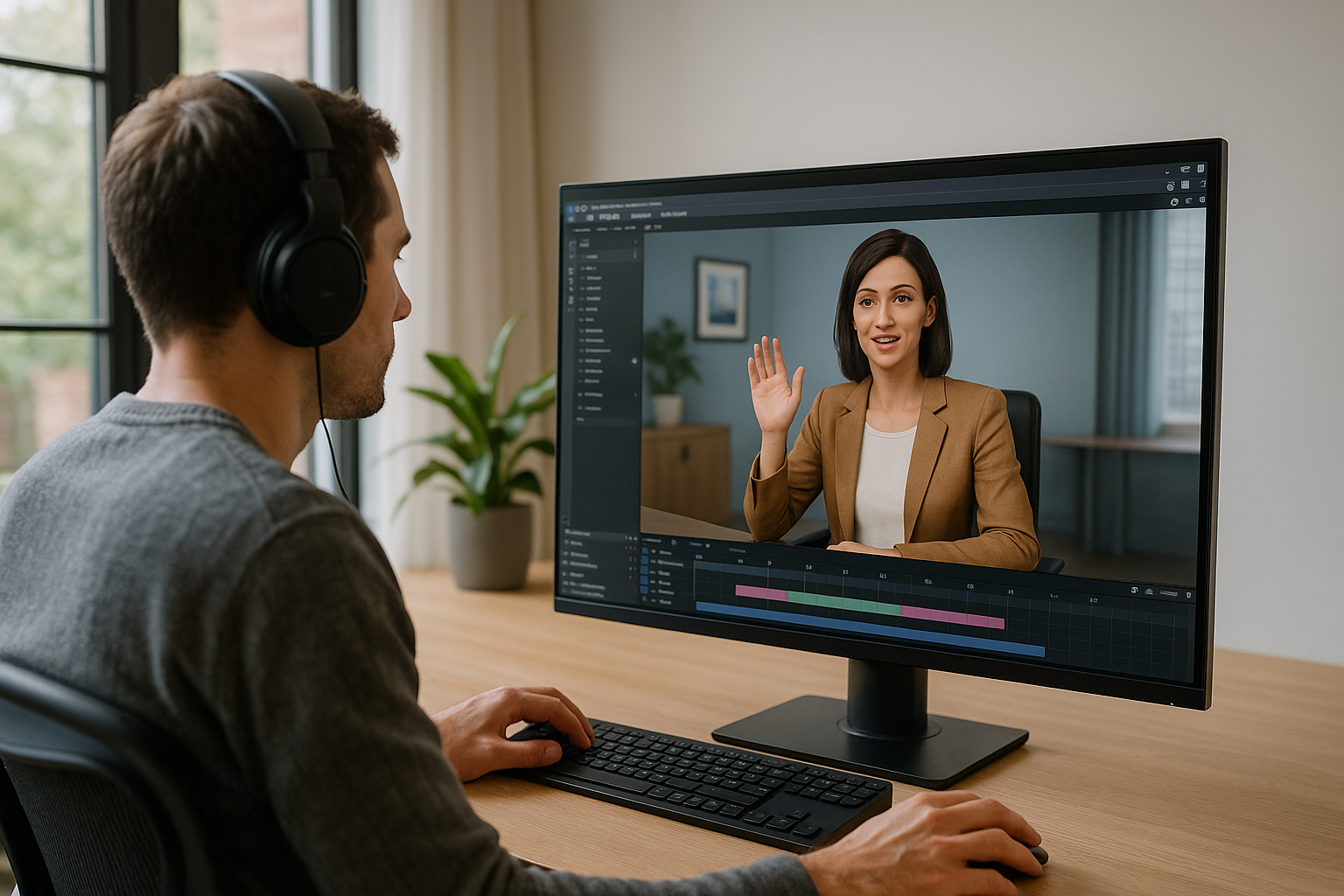Humanize Your E‑Learning Modules with VTS Editor’s Character Animation
Training managers, instructional designers, HR professionals: you want more engaging learning paths without extending your production schedule. With VTS Editor’s character animation, you add the often-missing non-verbal layer: gestures, postures, and micro-movements that emphasize speech, capture attention, and make your scenarios more believable. No coding required—trigger a greeting at the right moment, keep a conversation partner waiting with active listening, synchronize a nod with a correct answer—and thus create a strong social presence that fosters comprehension, motivation, and retention. Discover VTS Editor if you haven’t used it yet.
What Character Animation Enables in VTS Editor
The Character Animation block lets you trigger one or more animations on your characters (seated or standing), activate one-time or looped gestures, apply delays, and — if needed — wait for the animation to finish before continuing the scenario. You can quickly filter animations by type (general or emotional), preview your choices, and VTS Editor will alert you if an animation is incompatible with a character or posture. You retain precise control over pacing and meaning: animation becomes a true pedagogical tool—not just visual flair. To enrich your avatar and outfit options, explore the characters of VTS Editor.
Why Gestures Boost Engagement and Memory
Aligning Gesture, Emotion, and Gaze to Convey Meaning
Gestures clarify intention and reduce ambiguity. They guide the gaze, create visual cues, and strengthen alignment among what’s said (Speak block), what’s felt (Emotion block), what’s targeted (Gaze block), and what’s happening in the environment (Sound or Media in Scenery blocks). The result? A readable, credible scene that supports attention and memorization. In a corrective interview, an opening gesture sets a caring tone; a nod discreetly validates a good answer; a neutral stance reassures during sensitive moments. Behavioral expectations become visible—beyond textual scripts.
Research confirms the impact: gestures support thinking and learning by reducing cognitive load and enhancing memory encoding (Goldin‑Meadow, 2014). Perceived social presence in online interactions also improves engagement and satisfaction, enhancing learning outcomes (Garrison, Anderson & Archer, 2000).
Visual Cues That Direct Attention
Gestures act as attention cues. Have a character “point” to a screen, direct their gaze to a ringing phone, then display a contextual video using Media in Scenery. Gaze signals naturally direct the observer’s attention (Friesen & Kingstone, 1998). Pace an explanation: an illustrative gesture, a brief Wait pause, a Close-up to anchor a key message, then resume the dialogue. For training managers, it’s a way to turn a list of facts into a clear, well-paced story.
Who It’s For and When to Use It
This block supports L&D and HR teams working on behavioral and operational skills: communication, feedback, management, customer relations/sales, safety/HSE, compliance, onboarding, change management. Whenever posture matters just as much as words, animation makes the invisible visible and accelerates learning. Field feedback confirms the impact on engagement and completion—see our Manpower customer case.
Pedagogical Benefits of Character Animations
Clearer, More Credible Dialogues
The same line of text can feel cold without gestures; a neutral reply becomes clear when paired with a soft nod or calming hand. For an HR manager, this makes it possible to model expected behaviors visually—not just describe them verbally.
Enhancing with Emotion, Gaze, and Sound
VTS Editor shines when blocks are combined. Pair Character Animation (gesture/posture) with Emotion (facial expression and intensity), Gaze (learner, colleague, or object of interest), and Sound (effects and ambiance, using fade and spatialization). Example in retail: light in-store ambiance, a greeting advisor, a gaze toward the learner to build connection, and a Joy 1 emotion to support the welcome. The scene feels alive; the learner feels truly immersed. Animated pedagogical agents enhance social presence and learning (Mayer & DaPra, 2012).
Structuring the Narrative and Guiding Focus
Have a character point to a key element, mark a pause with Wait, zoom in with Close-up, then resume dialogue. This rhythm provides visual anchors, enhancing understanding and retention.
Engagement and Replayability
With Score/Check Score and Flags/Check Flags, the scene reacts to the learner. Above a threshold: confident posture; below: slight hesitation. After several correct choices, a more assertive gesture underscores progress. Learners want to replay, try other paths, and improve their score. Positive nonverbal behaviors (immediacy) are linked to better learning outcomes (Witt, Wheeless & Allen, 2004).
Step-by-Step Method: Succeed with VTS Editor Character Animation
Choose Animation (General vs. Emotional, Sitting/Standing)
Start with the learning goal—what should the learner understand or feel now? In customer relations, favor openness, listening, reassurance; in crisis management, go for alert and directive gestures. Check posture (sitting/standing) and set layout: avoid wide gestures near desks or walls. Use filters by name/type and preview to confirm readability in frame.
Adjust Timing: Delay, Loop, End
Timing changes everything. A 0.3–0.5 second delay after a line adds realism. Loops work well for listening postures or meaningful pauses—keeping the character animated without stalling the action. One-time gestures are ideal for greetings, pointing, reassurance. “Wait for End” halts progress until the gesture finishes—useful when the animation is the entire message (e.g., a safety signal).
Sync with Speak, Emotion, Gaze, and Sound
In Speak, use positive and negative delays for frame-perfect placement: a nod in the middle of a crucial phrase, a micro-pause simulating polite interruption. For Emotion, maintain consistent intensity: Emotion 1 or 2 for light gestures; if hitting level 3, add a Wait to ease back down. With Gaze, align the eyes with the gesture; with Sound, use subtle ambiance (fade, spatialization) to set the scene without overwhelming it.
Scene Orchestration with VTS Editor Character Animation
Several effective patterns in VTS Editor:
- Dynamic dialogue: Speak + Character Animation + Gaze + Emotion + Sound.
- Guided demonstration: Animation (pointing) + Media in Scenery + Step-by-Step Slideshow + Wait.
- Event reaction: Spatialized sound (phone on right) + Gaze (toward phone) + Animation (slight startle) + Speak (decision) + Decor Interaction (click).
- Strong transition: Close-up, posture recentralization, then Text Animation before resuming.
Accessibility, Clarity, and Performance
Enable subtitles and text-to-speech for accessibility and review. Aim for clear, unambiguous gestures; one strong movement with a few supporting micro-motions is better than over-animation that muddles intent. Avoid triggering too many animations across characters simultaneously. Test both on desktop and mobile to check framing. If combining loops, “wait for end,” ambiance, and video—monitor overall pacing: realism shouldn’t hinder progress.
Use Cases, Best Practices, and Pitfalls
Managerial interview simulation (feedback, assertiveness)
Set up a manager/employee duo. Start with neutral Emotion 1 and an open posture. The manager’s lines come with measured nods; delicate moments rely on a stable posture, direct gaze, and calming gesture. Employee phrase choices shape the outcome: a constructive reply raises the “communication” Score and reinforces confidence with a validating animation; a poor response triggers mild sadness or uncertainty + a recentralizing gesture that models expected assertiveness. A final Message delivers clear feedback.
Customer service/sales (greeting, objection, closing)
In a store, light ambient sound sets the context. The advisor greets, looks at the learner, and adopts a Joy 1 emotion. An objection? Trigger a reassuring gesture, direct gaze toward the objection (label, screen), and vary emotion between Uncertainty 1 and Confidence 1 depending on answers. Use Flags to store handled objections; Check Score can then trigger a confident posture past a threshold and maybe award a “Mastered Closing” Badge. Verbal and non-verbal work together to teach relational cues.
Safety and compliance (HSE, procedures)
In a workshop, a spatialized alarm sound triggers a gaze and alert gesture. Launch a Countdown to simulate real-time pressure, then present a decision Quiz. Upon validation, show the correct safety gesture via Character Animation; display a safety directive in the scenery using Media in Scenery; follow up with a reminder Message. This chain links decision-making, proper posture, and timing—just what HSE managers are after.
Creation Checklist
- Define the gesture’s intent: inform, reassure, alert, engage.
- Verify posture and compatibility (seated/standing, character, scenery).
- Set your timings: delay, loop, “wait for end” if needed.
- Sync with Speak/Emotion/Gaze/Sound; add Wait for pauses.
- Check in-frame readability and gesture–emotion–text consistency.
- Test on desktop and mobile.
- Ensure each gesture provides a useful signal for the learner.
Common Mistakes to Avoid
- Over-animation that tires the eye and confuses the message.
- Mismatch between gesture, emotion, and text.
- “Pointing” gestures off-frame—reframe or redirect attention via Gaze.
- Underusing Emotion/Gaze/Sound—multi-channel alignment is key.
- Ignoring software compatibility alerts.
Measure Impact and Optimize with VTS Perform
Link posture quality to performance using Global Score and Skill-Based Score. Via SCORM or VTS Perform, track progress, time spent, drop-off points, and replayability; analyze workflow trends. Use Badges to promote best practices (“Active Listening,” “Impeccable Safety Gesture”). Optimize using A/B testing through Random or Switch: Variant A with a reassuring gesture, Variant B with a demonstrative one; compare scores, completion time, and success rate. Get inspired by high engagement results in the Manpower customer case.
Take Action Now: Your Simple, Fast Plan
Express Roadmap (30 Days)
- Days 1–5: Choose a key scene; identify three high-impact pedagogical gestures.
- Days 6–10: Sync gestures + Speak + Emotion + Gaze; adjust timing.
- Days 11–15: Add Sound, Media in Scenery, and Close-up if needed for critical messages.
- Days 16–20: Create A/B animation variant; connect Score/Check Score and Flags for adaptive paths.
- Days 21–25: User testing; fine-tune loops, delays, and “wait for end.”
- Days 26–30: Deploy as pilot (SCORM/VTS Perform), measure, iterate.
Immediate Implementation
In your next scenario, add an opening greeting, a synchronized nod on a correct answer, and a looping listening posture during exploration phases. Always pair Speak, Emotion, and Gaze for consistent verbal/non-verbal alignment. Then expand: Sound to set context, Media in Scenery to illustrate, Close-up for key messages, Countdown to simulate urgency. For more options and support, explore VTS Editor and the Characters page. Your e-learning becomes dynamic—and high-performing.
Useful Resources and Evidence
- Gestures and learning: Goldin‑Meadow, S. (2014). How gesture works to change our minds. Trends in Cognitive Sciences.
- Gaze and attention: Friesen, C. K., & Kingstone, A. (1998). The eyes have it! Nature.
- Social presence and online learning: Garrison, D. R., Anderson, T., & Archer, W. (2000). The Internet and Higher Education.
- Animated agents and embodiment effect: Mayer, R. E., & DaPra, C. S. (2012). Journal of Educational Psychology.
In summary, VTS Editor’s character animation helps you build believable scenes, guide attention, and sustain long-term engagement—all without technical skills. Test, measure, improve, and harness the power of gesture for more effective training.










